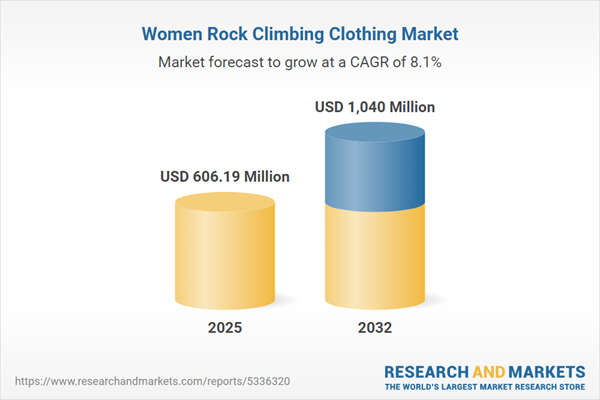Speak directly to the analyst to clarify any post sales queries you may have.
The women’s rock climbing clothing market is experiencing accelerated transformation as sustainability, advanced materials, and evolving consumer needs redefine competitive success. Senior executives face a dynamic environment that requires informed decisions grounded in targeted market intelligence.
Market Snapshot: Women’s Rock Climbing Clothing Market Growth
In 2024, the women’s rock climbing clothing market achieved a total value of USD 561.08 million, with projections showing an increase to USD 606.19 million by 2025 and USD 1.04 billion by 2032. This trajectory equates to a compound annual growth rate (CAGR) of 8.09%. Sustained demand is propelled by focused investments in technical garment design and agile enhancements to supply chain processes. The growing relevance of omnichannel distribution continues to shape how brands respond to consumers’ changing research and purchasing habits. As brands deepen differentiation on eco-friendly production and technical apparel features, market resilience and brand equity become strategic pillars.
Scope & Segmentation: Strategic Drivers in the Women’s Rock Climbing Clothing Market
A comprehensive understanding of this sector’s structural drivers helps senior leadership direct investments and identify expansion opportunities. This report outlines all critical categories for growth and innovation, providing managers with a blueprint for evaluating new market potential across multiple dimensions:
- Product Categories: Specialized climbing accessories elevate safety and user ergonomics, while advanced bottoms offer exceptional flexibility and toughness. Technical outerwear is engineered for performance under variable outdoor conditions, and multipurpose tops optimize comfort and adaptability.
- Material Technologies: Innovative synthetic blends—such as nylon-spandex and polyester-spandex—deliver stretch and high durability, supporting the core needs of active climbers. Additionally, the integration of natural fibers like cotton and merino wool enables sustainability benchmarks in product lines while maintaining comfort and breadth of use.
- Distribution Channels: Direct-to-consumer strategies, dedicated e-commerce verticals, and retail outlets play critical roles in aligning with the new purchasing preferences of the climbing community, ensuring global accessibility and robust service experiences.
- Geographic Regions: The Americas, EMEA, and Asia-Pacific each present distinct demands shaped by local regulatory standards, climate factors, and adoption trends—requiring brands to tailor product design, channel strategies, and compliance measures accordingly.
- Leading Companies: Brands such as Columbia Sportswear Company, VF Outdoor LLC, Patagonia Inc., Arc'teryx Equipment Inc., Black Diamond Equipment Ltd, Mammut Sports Group AG, Mountain Hardwear LLC, Rab Equipment Ltd, Outdoor Research LLC, and Prana Inc. are recognized for advances in innovation, technical expertise, and unique product positioning.
Key Takeaways for Senior Decision-Makers
- Continual advances in sustainability and product development allow brands to align closely with the evolving values of both established climbers and newcomers to the sport.
- Adoption of cutting-edge materials enhances product functionality, directly supporting compliance with emerging environmental standards and addressing new user preferences.
- Strengthening omnichannel capabilities blends digital and retail experiences, driving market reach and improving customer engagement at critical touchpoints.
- Building strategic alliances with technology providers and sourcing specialists accelerates adaptability and fosters proactive responses to industry-wide shifts.
- Region-focused supply chain refinement enables companies to respond effectively to varied regulatory landscapes, climate impacts, and local customer expectations.
- Emphasizing comfort, ergonomics, and high performance during product development increases customer loyalty and enhances brand trust among primary user groups.
Tariff Impact: Navigating Sourcing and Operational Shifts
With upcoming U.S. tariffs on synthetic and specialty fabrics scheduled for 2025, brands are reassessing sourcing and production strategies. Diversifying supplier networks, forging deeper partnerships, and prioritizing more sustainable, higher-value product lines have proven effective for managing input costs and strengthening supply reliability. These strategic steps are central to maintaining long-term operational continuity in a shifting regulatory context.
Methodology & Data Sources
This market analysis draws on detailed interviews with senior industry executives, feedback from professional climbers, in-depth reviews of corporate materials, and recent peer-reviewed research. Strategic recommendations are derived from SWOT and PESTEL frameworks, paired with proprietary quantitative data for comprehensive market evaluation.
Why This Report Matters: Women’s Rock Climbing Clothing Market
- Equips senior leaders with actionable intelligence to reinforce competitive market positioning and rapidly accelerate technical climbing apparel innovation.
- Provides robust frameworks that support anticipation of regulatory or sourcing changes, facilitate fast technology adoption, and enhance operational durability.
- Enables effective supply chain adaptation and procurement transparency as sustainability takes center stage within the outdoor performance apparel industry.
Conclusion
Securing long-term growth in women’s rock climbing clothing requires consistently anticipating customer needs, advancing technical materials, and tailoring initiatives to regional priorities. Strategic agility and a sharp customer focus will drive lasting leadership in this evolving sector.
Additional Product Information:
- Purchase of this report includes 1 year online access with quarterly updates.
- This report can be updated on request. Please contact our Customer Experience team using the Ask a Question widget on our website.
Table of Contents
3. Executive Summary
4. Market Overview
7. Cumulative Impact of Artificial Intelligence 2025
Companies Mentioned
The companies profiled in this Women's Rock Climbing Clothing market report include:- Columbia Sportswear Company
- VF Outdoor, LLC
- Patagonia, Inc.
- Arc'teryx Equipment Inc
- Black Diamond Equipment, Ltd.
- Mammut Sports Group AG
- Mountain Hardwear, LLC
- Rab Equipment Ltd
- Outdoor Research, LLC
- Prana, Inc.
Table Information
| Report Attribute | Details |
|---|---|
| No. of Pages | 186 |
| Published | November 2025 |
| Forecast Period | 2025 - 2032 |
| Estimated Market Value ( USD | $ 606.19 Million |
| Forecasted Market Value ( USD | $ 1040 Million |
| Compound Annual Growth Rate | 8.0% |
| Regions Covered | Global |
| No. of Companies Mentioned | 11 |









